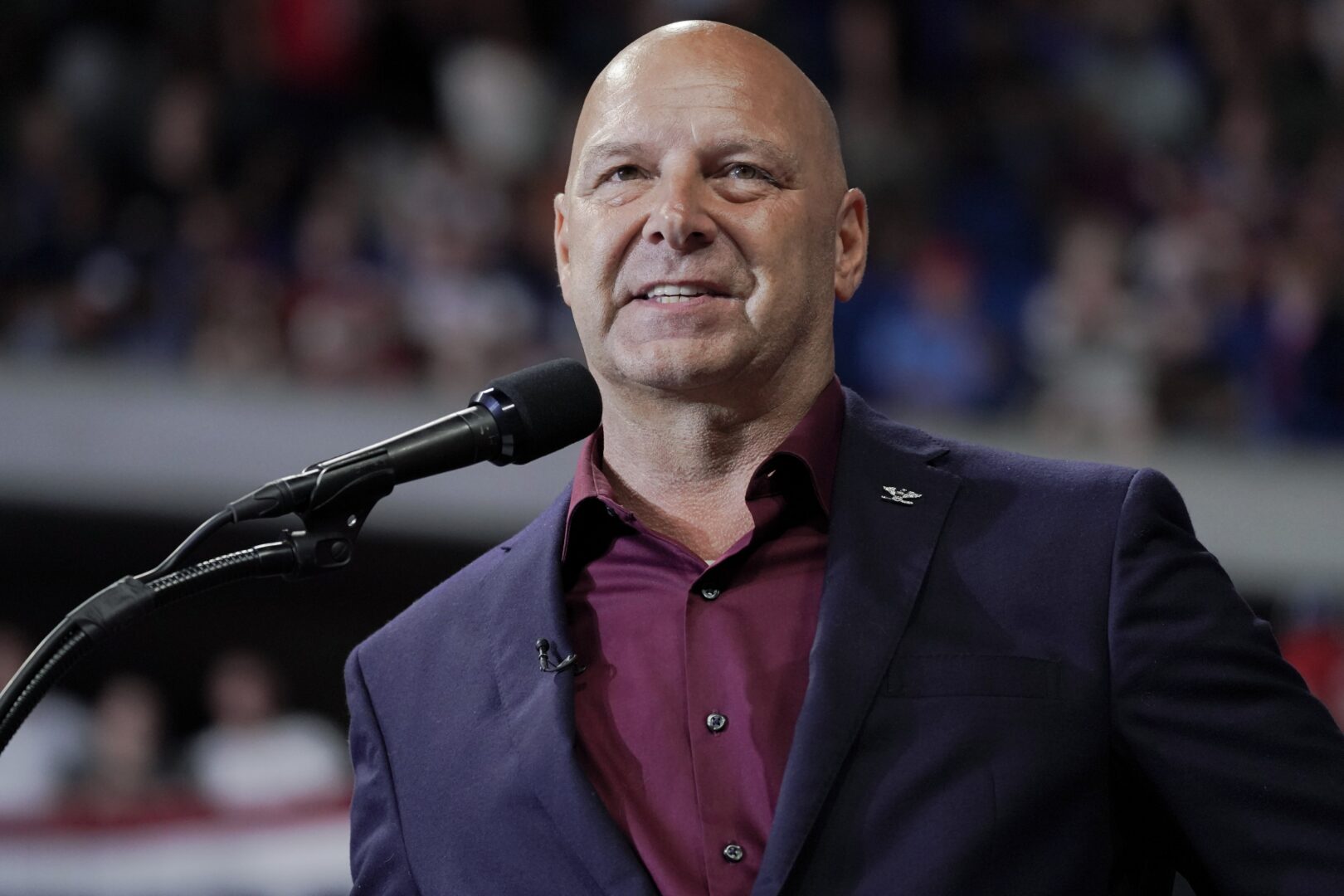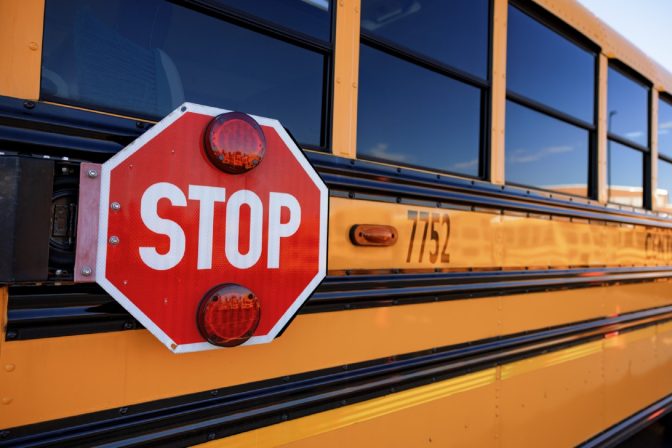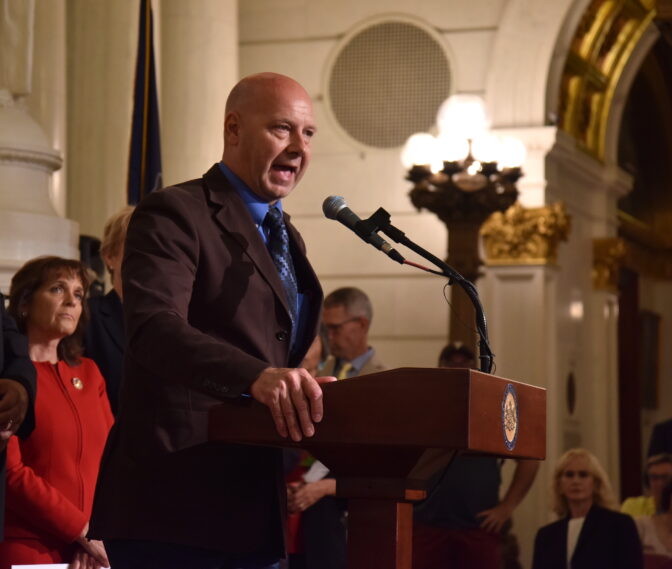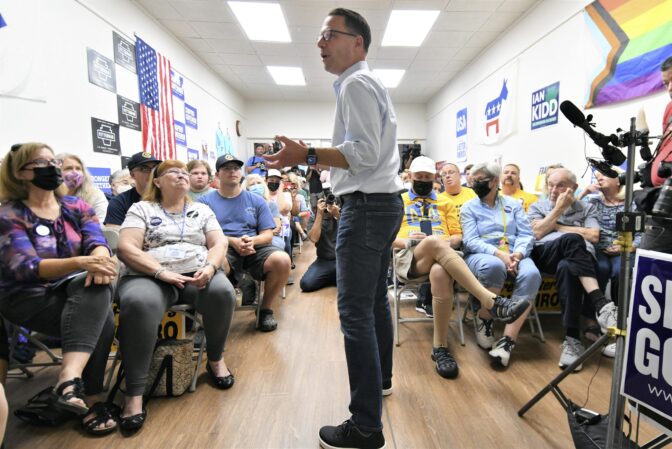
Pennsylvania Republican gubernatorial candidate Doug Mastriano speaks ahead of former President Donald Trump at a rally in Wilkes-Barre, Pa., on Sept. 3, 2022.
Mary Altaffer / AP Photo

Pennsylvania Republican gubernatorial candidate Doug Mastriano speaks ahead of former President Donald Trump at a rally in Wilkes-Barre, Pa., on Sept. 3, 2022.
Mary Altaffer / AP Photo

Mary Altaffer / AP Photo
Pennsylvania Republican gubernatorial candidate Doug Mastriano speaks ahead of former President Donald Trump at a rally in Wilkes-Barre, Pa., on Sept. 3, 2022.
During his campaign, Republican Pennsylvania gubernatorial candidate Doug Mastriano has alluded to proposals that would be a transformative overhaul of the state’s more than $30 billion K-12 education system, with public dollars eligible to fund students’ private education.
Mastriano’s sometimes conflicting statements have overall shown an effort to work with a likely GOP-controlled Legislature to propel far-reaching school choice programs by shifting state funds to students rather than schools.
This would allow for public funding to be used for students’ private education, homeschooling or religious schooling. Another key proposal has been the elimination of school property taxes — the largest contributor to districts’ budgets — which Mastriano has said would lessen the tax burden while saving the state money on education. Mastriano’s campaign did not answer a request for an interview.
The plan’s scant details have been denounced by the state’s largest teachers’ union and more than 80 school board directors statewide. Any resultant legislation could also be open to legal challenges.
Mastriano’s opponent, Democratic nominee Attorney General Josh Shapiro, has shown a willingness to embrace school choice programs, but he’s also advocated for securing more public education funding.

Commonwealth Media Services
School busses are pictured during a press conference in Pennsylvania, on Thursday, October 21, 2021.
WHAT HAS MASTRIANO SAID AND HOW WOULD IT WORK?
Mastriano has criticized the unions and “special interests” for “calling the shots” in public schools, suggesting school choice as the answer.
“Are you getting your dollars’ worth?” he asked at a March debate, taking aim at cost versus outcomes. “It’s time to put the power back in your hands.”
Under Pennsylvania’s current system, the state distributes billions to its 500 public school districts. This helps pay for salaries, building operations, transportation and more.
Under Mastriano’s plan, state funding dollars would instead go to students, and property tax dollars that typically go toward schools could be eliminated. Property taxes are the dominant source of income for schools, supplying nearly $15 billion in the 2020-21 school year, according to state data.
Mastriano has offered no plan to replace the lost revenue.
How much money goes to the kids under Mastriano’s plan has also waffled — he’s publicly said anywhere from $9,000 to $15,000 per student, down from the current state average of more than $19,000.
The Pennsylvania State Education Association responded, saying under Mastriano’s plan half of all school jobs — including teachers, counselors, support staff — would be eliminated and more than $12 billion in funding would be lost.
Mastriano rebuffed the criticism at a campaign event in Myerstown, saying he just voted in favor of increasing funding for public schools during the budget.
“These people are a bunch of liars, almost a billion dollars more in education spending, but ‘Mastriano is a danger to our education,’” he said. “Are you freaking kidding me?”
PSEA stands by its analysis.
“I think what Sen. Mastriano is trying to do is have it both ways and simply the math does not support that,” said PSEA President Rich Askey.

Sam Dunklau / WITF
State Sen. Doug Mastriano (R-Franklin), the 2022 Republican candidate for governor, addresses a crowd gathered for a rally celebrating William Penn in the state Capitol rotunda in Harrisburg on July 1, 2022.
IS SCHOOL CHOICE BETTER FOR STUDENTS?
There’s no research yet on how effective new programs are.
Research on older iterations has shown longer-term outcomes — like graduation and college enrollment — tend to be positive, said Martin West, academic dean at the Harvard Graduate School of Education.
Likewise, with older programs, there has been no evidence to show negative impacts on the performance of public schools or students who attend them.
However, the research doesn’t account for a proposal that potentially cuts public school funding while allowing students to use resources to enroll in private schools.
“Because that’s not what has happened elsewhere, and it’s not what’s been studied,” West said.
Marc LeBlond, director of policy for EdChoice, a school choice nonprofit, said choice allows for students’ needs to center in the conversation.
“What’s going to be the mechanism for the parent to make a switching decision? It’s going to be pain,” he said, adding, “The parents who are happy, the kids who are happy, they’re going to stay.”
During the pandemic, York parent Amelia McMillan chose to send her then-kindergartener to a cyber charter. It was chaos, she said, with her feeling ill-equipped to oversee her daughter’s education. Far-reaching school choice, coupled with drastic cuts to public education that many families rely on, concerns her.
“It would be awful,” she said. McMillan, whose daughter has since returned to a traditional public school, believes public education is what should be equalized. “Every kid deserves the same opportunities and public school gives that.”
HOW DOES SCHOOL CHOICE WORK ELSEWHERE?
The school choice system Mastriano is proposing is not new.
Arizona’s recently expanded program gives 90% of state education funding directly to families, though it’s already facing challenges by opponents. If the legislation is upheld, it will be the farthest reaching program in the country.
A similar effort in West Virginia last year was promptly met with legal challenges and was struck down, though an appeal will be heard by the state’s Supreme Court this fall.
“Private school voucher programs, in general, do raise many legal concerns and would likely be subject to constitutional challenges in Pennsylvania on multiple grounds,” said Maura McInerney, legal director of the Education Law Center, a legal and advocacy organization. The nonprofit declined comment on candidates and their platforms.

Marc Levy / AP Photo
Josh Shapiro, Pennsylvania’s Democratic nominee for governor, records a video message on Cindy Barnes’ cell phone for children after he spoke at a campaign event at Franklin County Democratic Party headquarters, Sept. 17, 2022, in Chambersburg, Pa.
WHERE DOES DEMOCRATIC NOMINEE JOSH SHAPIRO FALL?
While Shapiro has said he would fully fund schools, he has also highlighted choice for parents, including scholarships that allow students to get out of low-performing districts. Shapiro is endorsed by PSEA.
“I think it’s very important that we fully fund public education,” he said at a campaign event in Gettysburg earlier this month. “And I also think it’s really important that we empower parents to put their kids in the best place for them to be able to succeed.”
WHAT IS CURRENTLY IN THE LEGISLATURE?
There have been various efforts to advance education savings accounts in the Legislature — the closest has been the Lifeline Scholarship, which passed the House in April. An amended version now awaits action in the Senate.
The Lifeline Scholarship would make children who would attend a low-achieving public school eligible for state funding for alternate programming. That bill would grant most students $6,697 per year — and up to $50,000 for special education students. Approximately 10% of Pennsylvania’s roughly two million students — or 191,000 — would be eligible.
For decades, efforts to eliminate property taxes have failed without any way to agree on how to replace lost school revenue. A bill that would replace public schools’ revenue through raising other state taxes hasn’t moved through a House committee yet.
Marc Levy contributed to this report. Brooke Schultz is a corps member for the Associated Press/Report for America Statehouse News Initiative. Report for America is a nonprofit national service program that places journalists in local newsrooms to report on undercovered issues.
The days of journalism’s one-way street of simply producing stories for the public have long been over. Now, it’s time to find better ways to interact with you and ensure we meet your high standards of what a credible media organization should be.